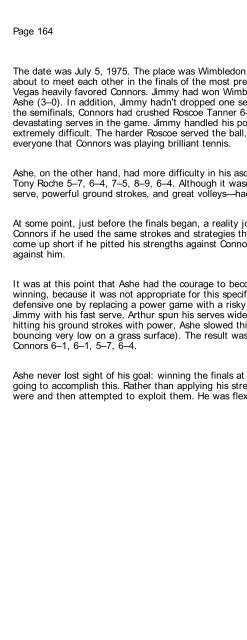1. The 15-Second Principle
1. The 15-Second Principle
1. The 15-Second Principle
You also want an ePaper? Increase the reach of your titles
YUMPU automatically turns print PDFs into web optimized ePapers that Google loves.
Page 164<br />
<strong>The</strong> date was July 5, 1975. <strong>The</strong> place was Wimbledon, England. Arthur Ashe and Jimmy Connors were<br />
about to meet each other in the finals of the most prestigious tennis event in the world. <strong>The</strong> odds in Las<br />
Vegas heavily favored Connors. Jimmy had won Wimbledon the previous year, and he had never lost to<br />
Ashe (3–0). In addition, Jimmy hadn't dropped one set in the entire tournament (six previous matches). In<br />
the semifinals, Connors had crushed Roscoe Tanner 6–4, 6–1, 6–4. Tanner had one of the fastest and most<br />
devastating serves in the game. Jimmy handled his powerful serve with ease. On a grass surface, this is<br />
extremely difficult. <strong>The</strong> harder Roscoe served the ball, the faster Jimmy returned it. It was apparent to<br />
everyone that Connors was playing brilliant tennis.<br />
Ashe, on the other hand, had more difficulty in his ascent to the finals. In the semifinals he'd outlasted<br />
Tony Roche 5–7, 6–4, 7–5, 8–9, 6–4. Although it wasn't smooth sailing, Arthur's main weapons—a fast<br />
serve, powerful ground strokes, and great volleys—had kept coming through for him.<br />
At some point, just before the finals began, a reality jolted Ashe. He realized that he was going to lose to<br />
Connors if he used the same strokes and strategies that had gotten him to the finals. He would once again<br />
come up short if he pitted his strengths against Connors's. Jimmy would take Arthur's power and turn it<br />
against him.<br />
It was at this point that Ashe had the courage to become adaptive. He abandoned his usual way of<br />
winning, because it was not appropriate for this specific situation. He exchanged an offensive strategy for a<br />
defensive one by replacing a power game with a risky game of finesse. Rather than trying to overwhelm<br />
Jimmy with his fast serve, Arthur spun his serves wide, favoring Jimmy's two-handed backhand. Instead of<br />
hitting his ground strokes with power, Ashe slowed things down and used more slice (which keeps the ball<br />
bouncing very low on a grass surface). <strong>The</strong> result was the biggest victory of Ashe's career. He beat<br />
Connors 6–1, 6–1, 5–7, 6–4.<br />
Ashe never lost sight of his goal: winning the finals at Wimbledon. He wasn't attached to the way he was<br />
going to accomplish this. Rather than applying his strengths, he looked to see what Connors's weaknesses<br />
were and then attempted to exploit them. He was flexible, resourceful,

















